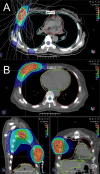Definitive radiotherapy with stereotactic or IMRT boost with or without radiosensitization strategy for operable breast cancer patients who refuse surgery
- PMID: 35849134
- PMCID: PMC9726698
- DOI: 10.1093/jrr/rrac047
Definitive radiotherapy with stereotactic or IMRT boost with or without radiosensitization strategy for operable breast cancer patients who refuse surgery
Abstract
For breast cancer (BC) patients who refused surgery, we developed a definitive treatment employing modern sophisticated radiation techniques. Thirty-eight operable BC patients were treated by conventionally fractionated whole-breast (WB) radiotherapy in combination with stereotactic (for primary tumor) or intensity-modulated (for primary tumor with/without regional lymph nodes [LN]) radiotherapy (IMRT) boost. Standard doses were 50 Gy/25 fractions, 21 Gy/3 fractions and 20 Gy/8 fractions, respectively, for the three radiation modalities. Disease stages were 0 (ductal carcinoma in situ [DCIS]) in seven patients, I in 12, II in 16 and III in three. In 26 patients, intratumoral hydrogen peroxide injection or hyperthermia with oral tegafur-gimeracil-oteracil potassium (S-1) was also used to sensitize the tumors to radiation. Hormonal and standard systemic therapy were administered in 25 and 13 patients, respectively. Complete and partial responses were obtained in 19 patients each; in patients with partial response, no further regrowth of the residual mass was observed, except for two patients who developed local recurrence. During a follow-up of 8-160 months (median, 50 months for living patients), two, one and two patients developed local relapse, sub-clavicular node metastasis and distant metastasis, respectively. The 5-year rates for overall, progression-free and local relapse-free survival were 97.2, 90.9 and 93.4%, respectively. Fourteen patients developed Grade 3 radiation dermatitis but all recovered after treatment. In 47%, the affected breast became better-rounded, and the nipple of the irradiated breast became higher by ≥1 cm than the contralateral nipple. Our method might be a treatment option for operable BC patients.
Keywords: breast cancer (BC); hydrogen peroxide; hyperthermia; intensity-modulated radiotherapy (IMRT); stereotactic body radiotherapy (SBRT); tomotherapy.
© The Author(s) 2022. Published by Oxford University Press on behalf of The Japanese Radiation Research Society and Japanese Society for Radiation Oncology.
Figures




Similar articles
-
Non-Surgical Definitive Treatment for Operable Breast Cancer: Current Status and Future Prospects.Cancers (Basel). 2023 Mar 20;15(6):1864. doi: 10.3390/cancers15061864. Cancers (Basel). 2023. PMID: 36980750 Free PMC article. Review.
-
Definitive Radiotherapy With SBRT or IMRT Boost for Breast Cancer: Excellent Local Control and Cosmetic Outcome.Technol Cancer Res Treat. 2018 Jan 1;17:1533033818799355. doi: 10.1177/1533033818799355. Technol Cancer Res Treat. 2018. PMID: 30222523 Free PMC article.
-
Adjuvant whole breast radiotherapy with simultaneous integrated boost to tumor bed with intensity modulated radiotherapy technique in elderly breast cancer patients.Transl Cancer Res. 2020 Jan;9(Suppl 1):S12-S22. doi: 10.21037/tcr.2019.07.19. Transl Cancer Res. 2020. PMID: 35117944 Free PMC article.
-
Locoregional Ablative Radiation Therapy for Patients With Breast Cancer Unsuitable for Surgical Resection.Pract Radiat Oncol. 2024 Jul-Aug;14(4):316-327. doi: 10.1016/j.prro.2023.12.003. Epub 2023 Dec 26. Pract Radiat Oncol. 2024. PMID: 38154688
-
[Evidence-based radiotherapy in the treatment of operable breast cancer: results in the 1990-ies].Orv Hetil. 2000 Jul 9;141(28):1551-5. Orv Hetil. 2000. PMID: 10957865 Review. Hungarian.
Cited by
-
BOMB trial: First results of stereotactic radiotherapy to primary breast tumor in metastatic breast cancer patients.Front Oncol. 2023 Mar 17;13:1062355. doi: 10.3389/fonc.2023.1062355. eCollection 2023. Front Oncol. 2023. PMID: 37007063 Free PMC article.
-
Non-Surgical Definitive Treatment for Operable Breast Cancer: Current Status and Future Prospects.Cancers (Basel). 2023 Mar 20;15(6):1864. doi: 10.3390/cancers15061864. Cancers (Basel). 2023. PMID: 36980750 Free PMC article. Review.
-
Treatment Options for Early Stage Inoperable Breast Cancer: Cryoablation or Radiotherapy?Breast Care (Basel). 2024 Apr;19(2):106-115. doi: 10.1159/000536413. Epub 2024 Jan 22. Breast Care (Basel). 2024. PMID: 38645759 Free PMC article. Review.
References
-
- Kinoshita T, Iwamoto E, Tsuda H et al. Radiofrequency ablation as local therapy for early breast carcinomas. Breast Cancer 2011;18:10–7. - PubMed
-
- Courdi A, Ortholan C, Hannoun-Levi JM et al. Long-term results of hypofractionated radiotherapy and hormonal therapy without surgery for breast cancer in elderly patients. Radiother Oncol 2006;79:156–61. - PubMed
-
- Mukai H, Watanabe T, Mitsumori M et al. Final results of a safety and efficacy trial of preoperative sequential chemoradiation therapy for the nonsurgical treatment of early breast cancer: Japan Clinical Oncology Group Study JCOG0306. Oncology 2013;85:336–41. - PubMed
MeSH terms
Grants and funding
LinkOut - more resources
Full Text Sources
Medical

